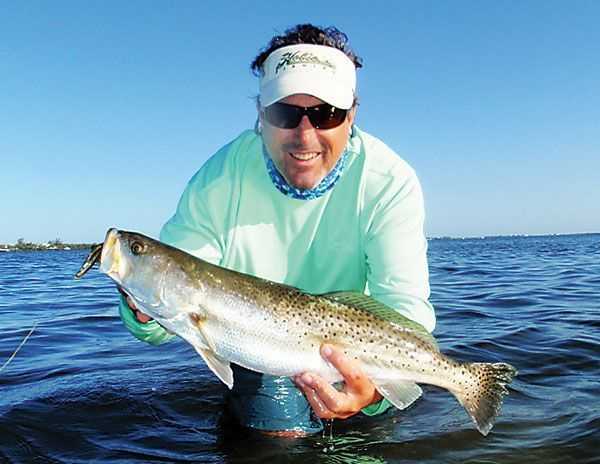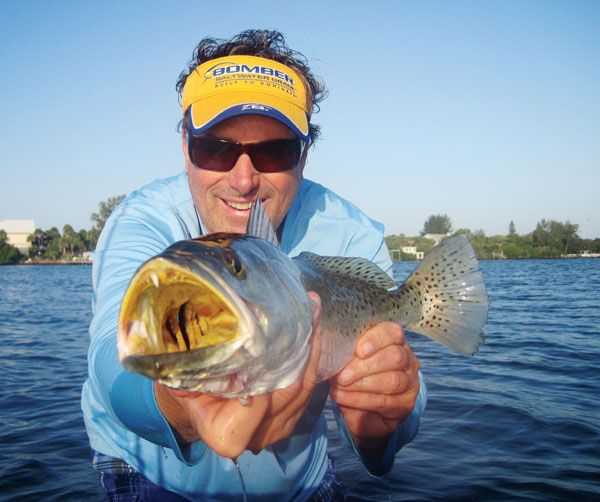I won’t deny that when it comes to fishing I can be a bit of a snob. This led me to eliminate all species other than redfish and snook from my inshore target list over the last several years. The spotted sea trout, once my number one target, had fallen off my radar. The only time I would find myself fishing for trout would be when they were a required species for a tournament. Otherwise, I usually only caught them as by-catch.
Fortunately, over the last two years enthusiastic reports of monster winter time trout here in Florida, have me in pursuit of this grand species once again. Fellow Hobie team member Cameron Schurlknight, always seem to have trophy sized trout dialed in during the colder months. Cam’s failsafe plan to land one of these jumbo female trout is to first locate an area that has an abundance of small sandholes. The largest of trout are usually always female. The biggest of the species range from 5 to 8 lbs here on the West Coast. The holes most likely to hold monster specks are usually less than five foot in diameter and about knee deep in depth. Cameron adds that mullet play a huge role in his determination of where to locate the largest of the yellow mouths. He feels that if there is not a plethora of mullet present it is likely that the trout will be absent from the area as well. These big girls hug the edges of the holes using the adjacent grass flats as camouflage. Large trout feed almost exclusively on bait fish. They lay in wait on the edges and ambush smaller bait fish as they swim over the open space of the hole. This scenario makes casting key. It is important to cast to one of the edges and naturally bounce your jig out into the open, making it irresistible to a big girl laying in wait.
Cameron favors the Slayer SSB in the Houdini color. He rigs it on a one-eight ounce jig head and makes sure that it bounces from edge to edge puffing up sand to draw the attention of his target. As for me, I have had the most success using a saltwater Assassin Sea Shad in the Mudbug color. Both of these soft plastic baits are dark in color and are a perfect contrast to the light color of the sand. This contrast makes it an easy target for any hungry trout. We both agree that presentation more than anything else is the key. It must look as natural as possible. While we prefer our favorites, I believe that any dark color will suffice. Pick one that gives you the most confidence.
While a 5 lb trout has the ability to pull a little, I prefer to use light tackle with a looser setting on my drag. Use just enough drag to set the hook. If the drag is too tight, your fish may become unbuttoned as their soft mouths easily tear. A medium light 7 foot rod with a 2000 to 3000 class reel spooled with 10 lb. braided line is perfect. Fluorocarbon leader is a must as the sand will reflect even the smallest of shadows and there is no reason to go heavier than 20 lbs. on the leader. While I prefer using small jigs, these big fish can be taken in other fashions. The most popular technique is using either a popping cork or a rattling cork like the Cajun Thunder. By running about 18 inches of leader from the cork, you can hang the bait in the strike zone while a varied series of pops will attract your quarry’s attention. A large shrimp, pinfish or artificial like the DOA shrimp are the most proven baits to run below the cork. This method is often preferred with fishing with novices but they are a few “old salts” that will put any angler to shame using this rig. While topwater baits are responsible for many of the largest specks during warmer months, they will still land some large trout throughout the winter, especially if the temperatures are moderate. Don’t be afraid to give your favorite plug a few casts, especially amidst an abundance of mullet. While these are the tactics we use in Florida, they are easily adaptable to where ever you target seatrout.
If you catch one of these beauties make sure you handle them with care. Their only protection against predators is their slimy coating. Try to keep them wet while taking photos and never use a towel to handle them as you will remove their natural defense. Here in Florida you may keep one fish over 20 inches, but it is best to release the big breeders to reproduce more of the same.
Pedal On!
[easy-social-share]

